 «Home
«Home «Home «Home |
The Bells Rehanging Project
WINTERBOURNE
|
|
Rehanging the Church Bells.
The Bells Project 1983-1985
Information is being added to this page on a regular basis.You'll also find more about the bells in the »CHURCH GUIDE
This is the original 7"x 8" sketch by Dr Chris Greef that got the project started!
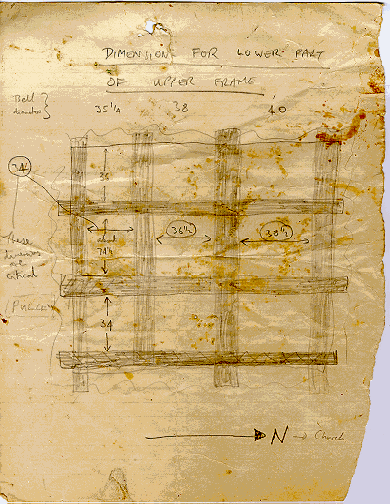
This web page is based on an article first written by » John Kite, a member of the Bells Project Team, and published in the "The Ringing World" (the weekly journal for church bell ringers) on April 19th 1985. Sources are: reports and presentations to PCC, Winterbourne Parish Council, bellringers special meetings; articles first published in the Church magazine, and diaries and notes taken at the time.
You can look at some of the source documents on » Rehanging the Bells Project Diary
and some more photographs on » Rehanging the Bells Project PhotogalleryWinterbourne's ambitious 2-year D-I-Y project
by John KiteA rededication service by the Rector, the Rev. Edward Bailey, on Sunday 21st April 1985 marked the end of an ambitious two year do-it-yourself project in Winterbourne, a large village just north of Bristol which saw a small dedicated team of volunteers at St Michael the Archangel rehang the maiden peal of six bells in new steel frames.
The Evans Bell Foundry at Chepstow
We are lucky to have a complete set of bells all of the same date (a 'maiden peal') for this makes our tower unusual. Generally, even if all the bells in a tower were cast at the same time, one or more bells has cracked (comparatively few Evans bells have ever needed re-casting - proof of sound workmanship and good material) and has had to be re-cast, or else the original set has been increased by adding extra bells. Evans tended to go for complete rings rather than augmentations, mostly 6s and 8s up to about a ton in weight and the bells did not carry much decoration.
The Church Bells of Monmouthshire. Arthur Wright BSc
"The Evans foundry at Chepstow flourished from the 1680s until 1767. Evan Evans I was active until 1724. He had two sons, Evan II and William. William was the most active, with bells from 1710 to 1767. He died in 1770 at the ripe old age of 80". In the early 1700s it was the practice of many bellfounders to cast their bells on site due to bad conditions for road transport, and in 1718 Evan Evans cast on-site a ring of six at Llantrisant Church, Glamorgan. Mr George Massey of the Central Council of Church bellringers (Towers and Belfries committee) considers it unlikely that William Evans would have done any casting in our churchyard especially as water transport was handy and the old founders only resorted to this when very big bells were involved.
Chepstow was a good place to have a foundry in those days of virtually no roads, and Evans bells found their way to Somerset, Devon, Cardigan and even Lancashire. On a visit to Chepstow to try and find out more about the foundry, Tower captain Chris Greef was surprised to discover that it had been at the top of a hill behind the castle, rather than close to the river where the bells could more easily be loaded onto boats.
The Bristol Turnpike was already completed by this time, so it is likely that the bells were loaded aboard a ship or barge at Chepstow docks, across the Severn to Bristol docks, where they were unloaded onto carts and transported to Winterbourne along the Old Gloucester Road Turnpike.The construction of the frames (massive timbers with all joints pegged together with dowels) is impressive, but since the original installation of the bells in 1757 by William Evans of Chepstow, the oak frames have been ravaged by wear, weather and woodworm. Strengthening of the frames was carried out in 1876 and during the 1930s and 1960s.
Belltower expenses (from the Parish Records).
Statement of Receipts May 1877. 3. New beams have been put in the belfry in place of some of the old ones which were unsafe. Belfry £115.The account for work done. Obviously, not very well done.....
(Mr Shipway was sexton)
Bell expenses in the Parish records
The remedial work failed to stop the slow disintegration of the frames, particularly the joints, and for many years the bellringers considered how best to raise funds to have the bells rehung. By early 1982, the need to rehang the bells was becoming urgent. At the same time, it was obvious that a major fundraising effort to raise £20,000 for the rehanging work would not only be difficult, but would divert funds away from other good causes in the village. Terry Jefferies, the Tower Captain, stunned members present at the bellringers AGM in mid 1982, by suggesting the possibility of a do-it-yourself rehanging project as a solution to the problem!
A feasibility study
Terry Jefferies and Dr. Chris Greef carried out a feasibility study over the next few weeks, and their work showed that it would be possible to install new steel framework at a lower level in the tower without disturbing the existing bellframes, so that once the construction work was complete, the bells could be lowered from their old frames straight into the new frames! Many other alternatives were considered during the study but it was felt that the simplicity of this scheme would put it within the capabilities of a volunteer team. Indeed, keeping the bells up in the tower rather than having to lower them out of the way was considered crucial to the success of the scheme.A village meeting was called at 10am on Saturday 18th September 1982 to discuss the future of the Church bells and the results of the study were presented. There was strong support for a DIY scheme and several people volunteered their services: in particular, Don Rix, a Chartered Structural Engineer offered to draw up plans for the new steel frames.
"Bells Project Team" formed
The strength of support from the village convinced the bellringers that a DIY scheme was possible and they decided that it was time to organise the project on a formal basis. The bellringers formed the "Bells Project Team" with Tower Captain Terry Jefferies as the Project Leader.
Their brief was clearly defined:1. To carry out thorough and detailed planning for all stages of the proposed project to identify any problems that might prevent completion (for the consequences of reaching a stage of no return and then being unable to complete the job would be serious).
2. To bring together sufficient expertise to carry out the work.
3. To raise funds for materials.
4. To seek approval from the Parochial Church Council.
5. To obtain a faculty from the Diocesan Advisory Council for permission to proceed with the project.Dr. Greef became clerk of works, responsible for the detailed planning of the project and it was his task to liaise with Don Rix and the church advisors with a view to eventually obtaining DAC approval for the scheme.
Bells Project cost estimates.
The Winterbourne tower was visited on Saturday 2 April 1983 by Mr George Massey and after a close look at the tower in conjunction with the bellringers' plan, made the following comments:
"Existing Bell Installation. The present bellframe is of poor and obsolete design and should be replaced. It is not of historic interest and need not be preserved.
The new proposals. The intention to re-hang the bells lower in the tower is sensible and will be beneficial to the tower structure.
Foundation beams. It is imperative that there should not be any vertical or lateral distortion of the bells when ringing ......"Whites had already rehung St John's, Chipping Sodbury, in a wooden frame for £20 000.
Taylors of Loughborough came to examine the Winterbourne tower. Their estimate was £19 500 using cast iron sections, plus £500 to rebush the clappers (this was surprising as the job had been done in the 1960s).
Good publicity the key
It was considered by the team that the key to success for the project would be good publicity, and so news of the bells project was spread round the village. Large diagrams of the intended programme of work, showing the various stages in the project from start to finish were produced as practical details were being worked out, and a first report and presentation on the proposed bells project was made to the Parochial Church Council in early November 1982.With Christmas fast approaching, thoughts turned to fundraising. The bellringers carried out a local Christmas Card delivery service and this was a good fundraiser and good publicity. The Winterboume Handbell ringers (who incidentally form the nucleus of the St. Michael Bellringers) donated the proceeds of their annual charity handbell concerts to the bellfund. At the next bells progress meeting in late January, the treasurer Gill Greef was able to report that there was nearly £700 in the kitty! For the future, a Flower Festival was arranged in conjunction with the PCC and the Winterbourne Flower Arranging society to celebrate "225 years of bells at St. Michaels, Winterbourne" at Harvest Festival.
Planning now complete
The detailed planning stage was now complete: Chris, in conjunction with John Turner, Terry and Antony Jefferies, Garry Crisp and Don Rix had discovered several problems, but had found ways round them. At the same time, improved methods of carrying out some of the stages had been devised that would save considerable time and energy later on.A report was presented to the PCC on 1st February, outlining the plan of action:
1. Build a reinforced floor in the ringing chamber to replace the rotting wooden floor. This would be an easy exercise which would give the team some experience of working together before tackling the major part of the work.
2. Build the lower frame for bells five and six in the clockroom (after removing the disused 17th century clock mechanism!) and dismantle the old wooden frame.
3. Build the upper frame for bells one, two, three and four and remove the old wooden frame.The PCC agreed that the bellringers had presented satisfactory proposals and evidence of intent for the DIY project and agreed to forward the plans to the DAC for approval.
Concern over money
The thought of having to raise the estimated £3,500 for materials for the project was beginning to cause concern. £700 had been raised by the bellringers but it was going to be difficult to raise funds and work on the project as well, so a fundraising meeting was called for late February.Fred Carslake, a local resident, came to the meeting with ideas for a fundraising event in the village. In May 1983, Fred Carslake and his team of helpers organised "It's a Knockout! " in the village - an event that was so successful that Fred was able to hand over a cheque for nearly £1,500 to the bellfund.
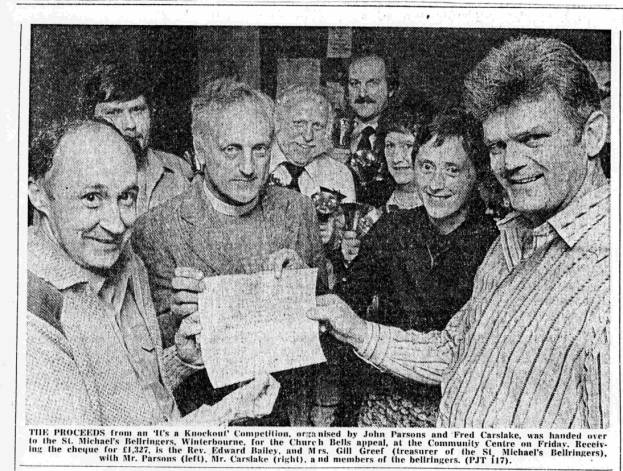
Front: John Parsons, Canon Edward Bailey, Fred Carslake. Rear: Antony Jefferies, Terry Jefferies, John Turner, Brenda Jefferies, Gill Greef.The result of the publicity from the various fundraising activities brought several volunteers to the project, including Dennis Banfield who was able to co-ordinate and supervise the many heavy lifting operations. It also produced contacts for obtaining supplies of steel and timber.
Work starts
The wait for DAC approval was to prove a long one, but following a site inspection the team were able to start on some preliminary work for the project.
Parish Church Weekly Notes,16 October 1983Heavy lifting equipment was hauled up the tower and a massive steel jib mounted in the tower to support three heavy pulley blocks, two for lifting work inside the tower, and one for lifting materials outside the tower.
Steel jib for heavy lifting outside the tower.It was realised even before this stage that the confined space of an old church tower is a dangerous place to carry out a bells rehanging project, with accidents just waiting to happen, and John Turner was appointed Project Safety Officer. Under his careful supervision, the project remained mainly accident-free.
Construction work started proper with the installation of a new wooden floor on a steel frame in the ringing chamber. Old pieces of clay pipes were found when the floorboards were removed. The plan to rehang the bells lower in the tower was to be achieved by building the steel frame for bells five and six in the clockroom, so the disused clock mechanism was dismantled and removed for restoration by a local member of the British Antiquarian Horological Association.
A hive of activity
The faculty for the project was finally received in late September 1983 and the project team swung into top gear. Over the next few months the tower was a hive of activity: holes were knocked in the tower, walls and concrete padstones cast. The logistics of this exercise were formidable. Unable to obtain the services of a Readymix lorry high in the tower, the team were forced to fetch and mix the aggregate, cement and water and haul it by the bucketful up outside the tower!


Heavy lifting proves difficult
But it was the heavy lifting operations that were to prove the most difficult and the most exhausting - especially at the height of summer. Large (and very heavy!) rolled steel joists were hauled up outside the tower, manoeuvred through a small window opening into the tower, down into the clockroom and bolted into position on the padstones.
Heavy lift in progress.
Heavy lifts were not always successful. Here a recovery team member abseils down the tower on Sunday 9th September 1984 to free a shackle fouled on the clockface.
Heavy lifts were not always successful. On one occasion a lift went wrong and the RSJ returned to ground level, not fully under control!Eventually, a massive rigid steel grid was formed on which to build up the bellframes.
It was a great cause for celebration when Chris, the clerk of works, checked the job with rule and spirit level and found that the job was perfect, which was a fitting end to the first major task the team had performed together. It was then a fairly simple job by comparison to lower bells five and six from their old wooden frames onto the new steel grid and dismantle the old oak frames, to await the building of the new support frames!

Oak frames in churchyard awaiting disposal.

Oak frames being dismantled by Tower Captain and Project Leader Terry Jefferies, John Kite, Steve Smith.
Oak beam being removed from tower.Much of the original oak framework was found to have been damaged by death-watch beetle, and sections through the timbers showed extensive infestation. The oak framework was held together with wooden pegs, and at least one peg was eaten completely in half.
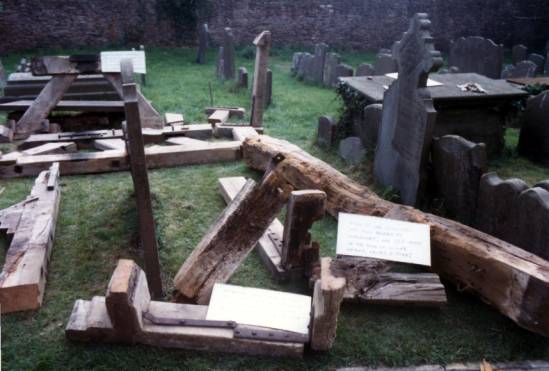
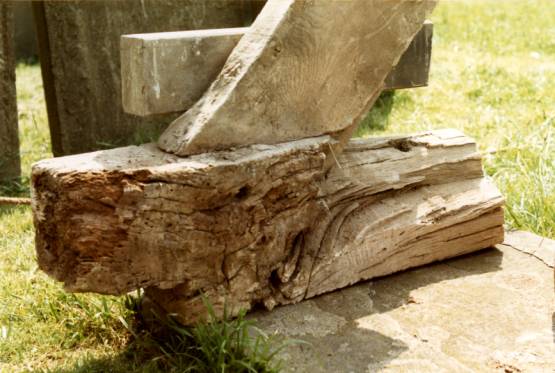
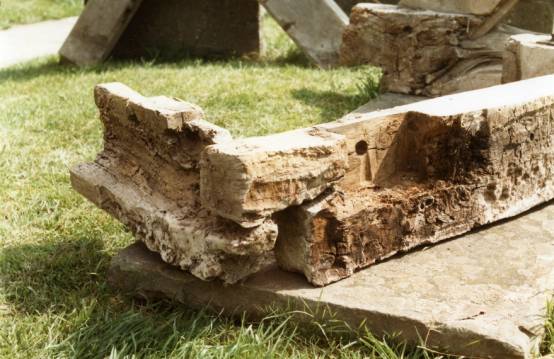
However, some of the frame was used by Dennis Banfield to craft new window frames and a new wooden ceiling for the ringing chamber. Dennis started the work on 23rd March, working during the week, and by the next weekend he'd finished the ceiling!
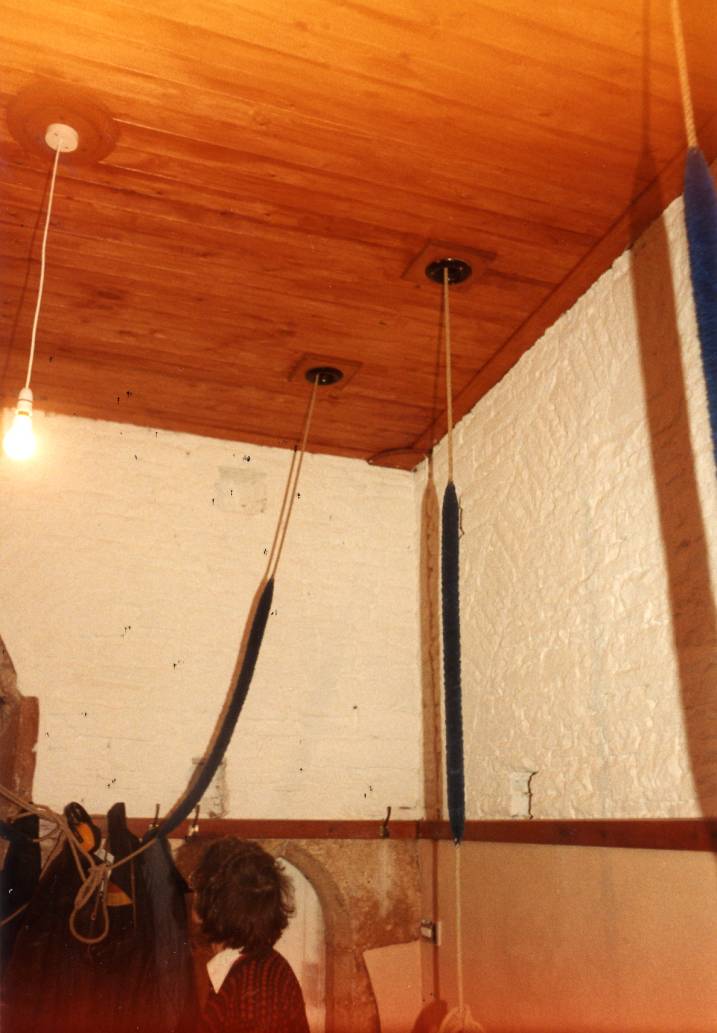
Mr A Tearle of Winterbourne selected some pieces of oak to turn some chalices on his lathe. The heaviest timbers were sold to Ushers Brewery to be used in "The Crown" at Staple Hill, although it appears they finally finished up in a pub in Bath.

23rd March: Large oak being loaded onto a lorry from Ushers Brewery,Trowbridge, bound for "The Crown Inn"
Chris Greef, Ushers driver, unknown, John Kite, Dennis Banfield, Dave Marsh.The same procedure was then repeated for the upper frame by a team that was now flushed with success and buoyant with enthusiasm - but this was soon dampened when the lack of working space became apparent: bells below and bells above made the job of placing steel joists in position doubly difficult. Nonetheless, the second stage was completed as successfully as the first, although it took considerably longer to reach this milestone.
At the lower level
Over the next few weeks work started again at the lower level when the component parts of the support frames were made and delivered. These were assembled and bolted together and bells five and six fitted on new bearings.Back at the upper level bells one, two, three and four were lowered onto the grid. Removal of the oak frames at this stage gave the team their only heart-stopping moment during the whole project. This was as the last (and by far the largest) oak beam was being lifted out. It took an hour to move the old beam into position by the window which seemed to be too small! It was then hooked to the outside jib, and launched through the window and into space. When the cloud of dust, crumbling masonry and rotting timber had cleared, the team heaved a sigh of relief to see the beam majestically swinging on the jib of the crane, ready to be lowered to the ground.
Pace slows down
From then on the problem of restricted working space became worse. Until the supporting frames had been built up and the bells rehung, all four bells were always in the way and had to be constantly moved around. So the pace of the project slowed down. Space was so cramped that only three people could attempt to work at the upper level. The risk of falling steelwork, tools or debris stopped work on the lower level, and so work was started in the ringing chamber. Here the old plaster was chipped off the walls to expose the original brickwork.The final touches
All six bells were hanging from their new frames by late December 1984.
Here's the diary entry which celebrated the technical success of rehanging all six bells!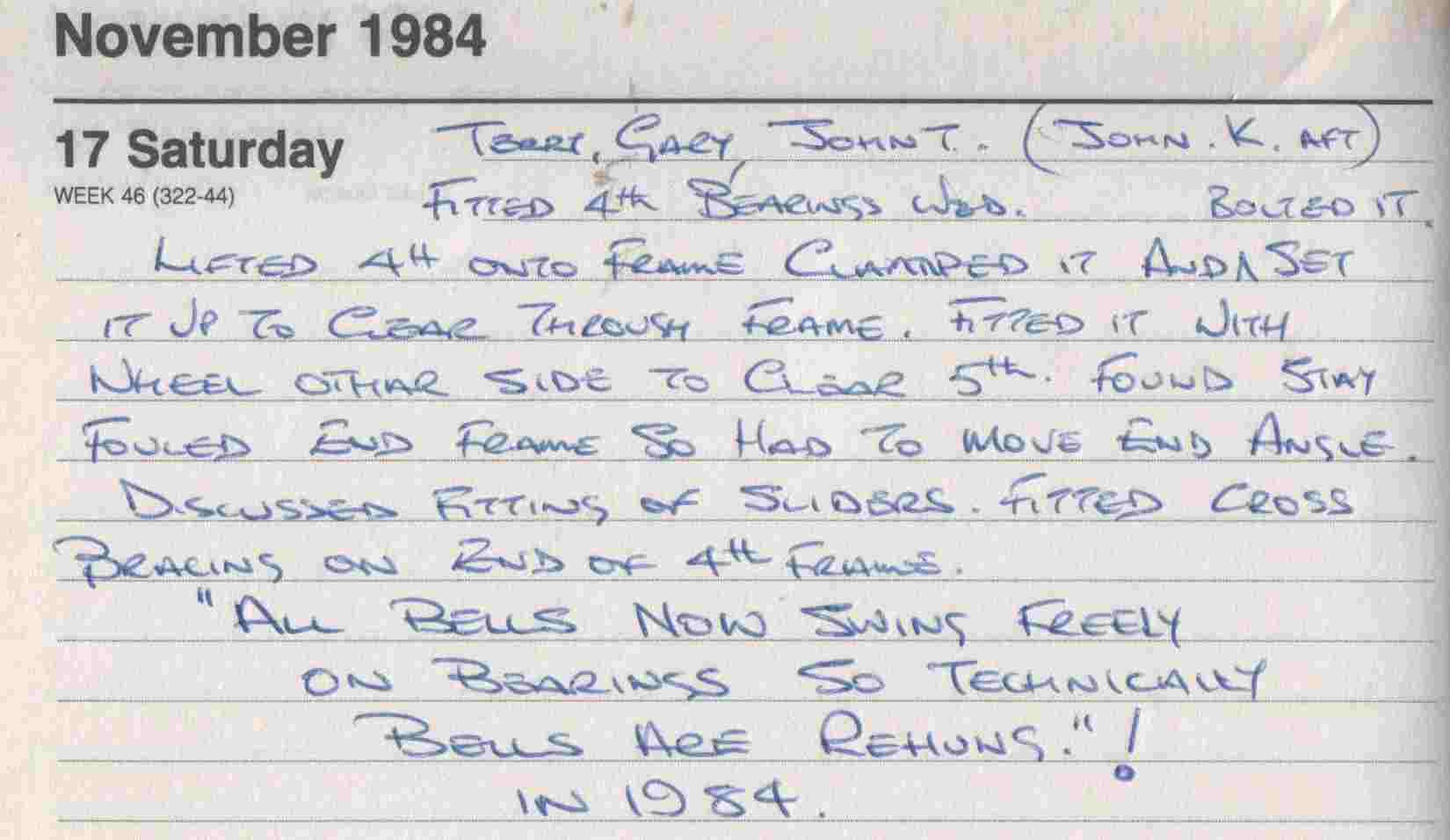
Towards the end of the bells project, Terry, Brenda and Antony Jeffries went to the Whitechapel Bell Foundry with two cracked handbells for repair. During their visit on 27th November they were shown the 1757 records for our bells, and also saw a steel frame under construction for another tower. The frame looked flimsy after ours!
The final touches, like the jobs of fitting and adjusting sliders and pulleys, took another few weeks. It was a historic moment for the team in February when each bell was rung to check that all was well.
The bells hung silent while other work was carried out. A new ceiling with sound-proofing was fitted, and the opportunity was taken to install new lighting and power high in the tower, and a pair of floodlights on the spire.
The rededication service, and the sound of bells once again, ended the story of the DIY rehanging project at St. Michael's, Winterbourne, where the village bells were given a new lease of life thanks to the enthusiasm and determination of a few bellringers and their friends.
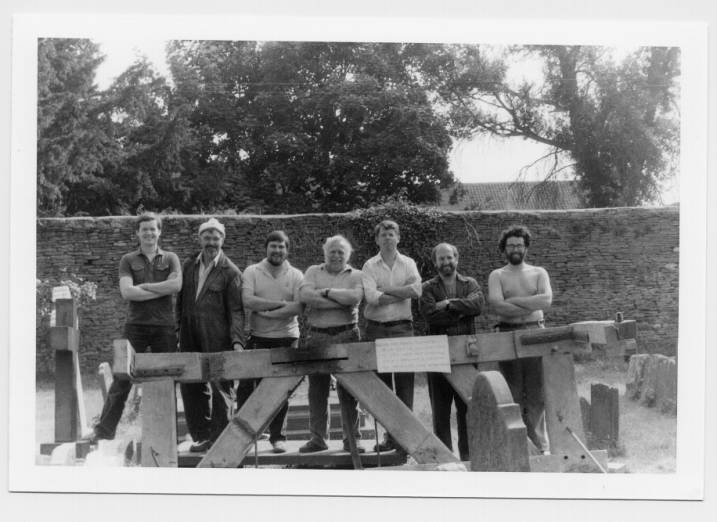
from 'The Ringing World' 19th April 1985.
Steve Smith, Dennis Banfield, Antony Jefferies, Terry Jefferies, John Kite, John Turner, Garry Crisp
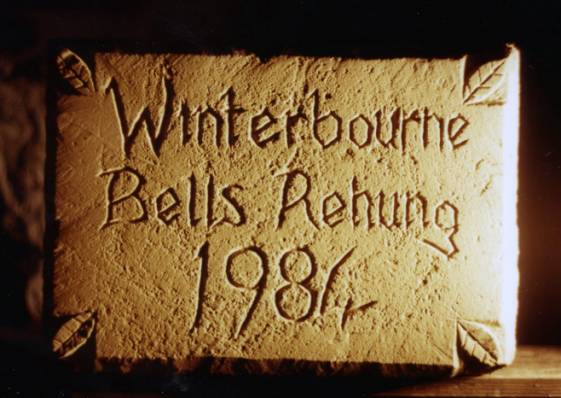
Diagrams of the Bells Rehanging project.


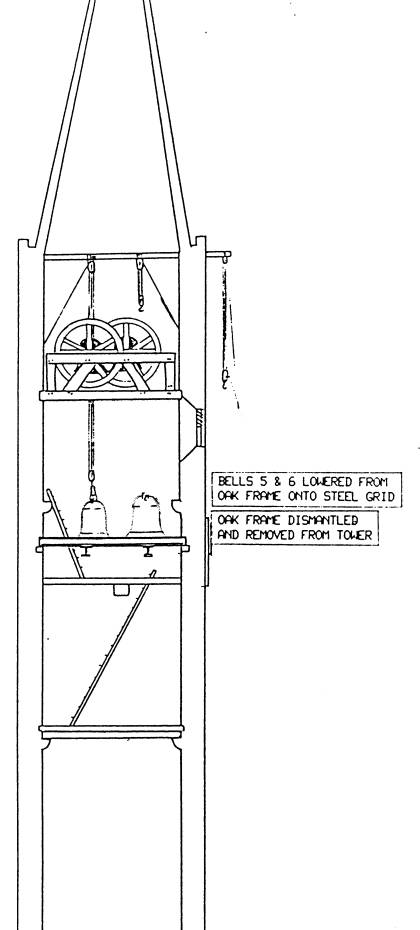
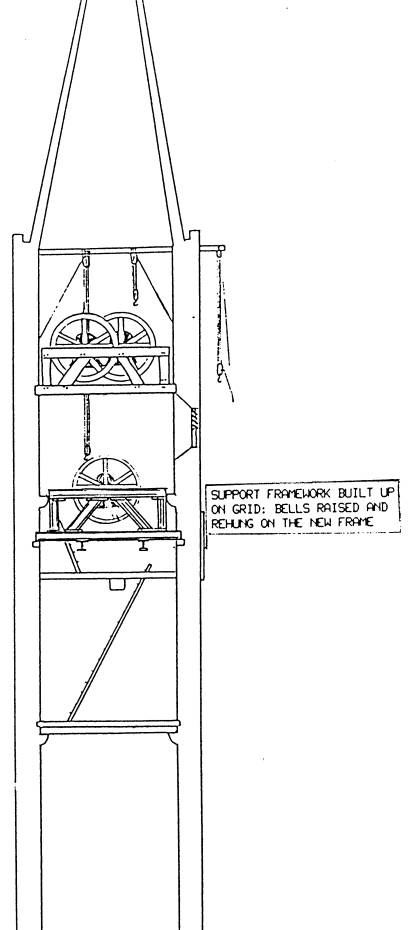
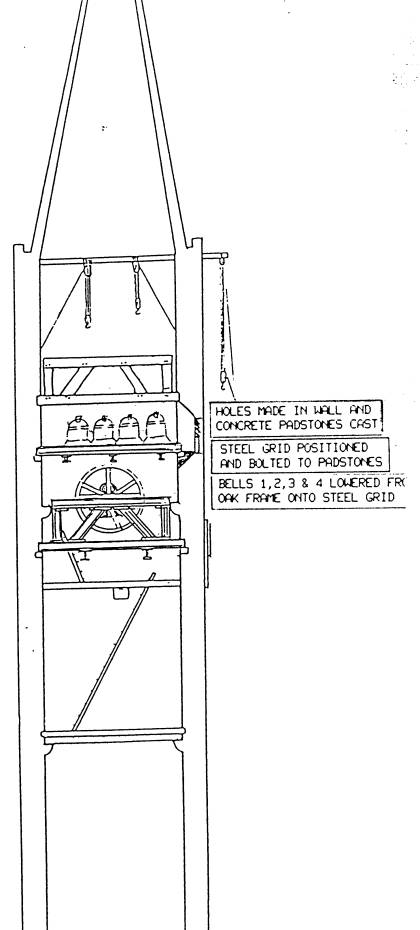
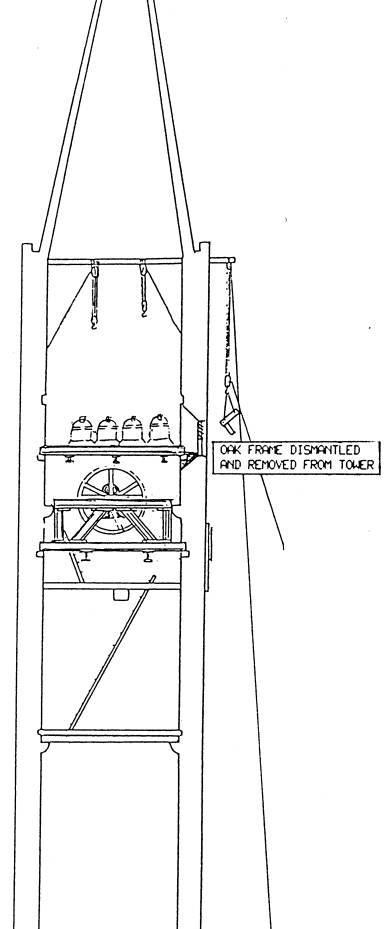
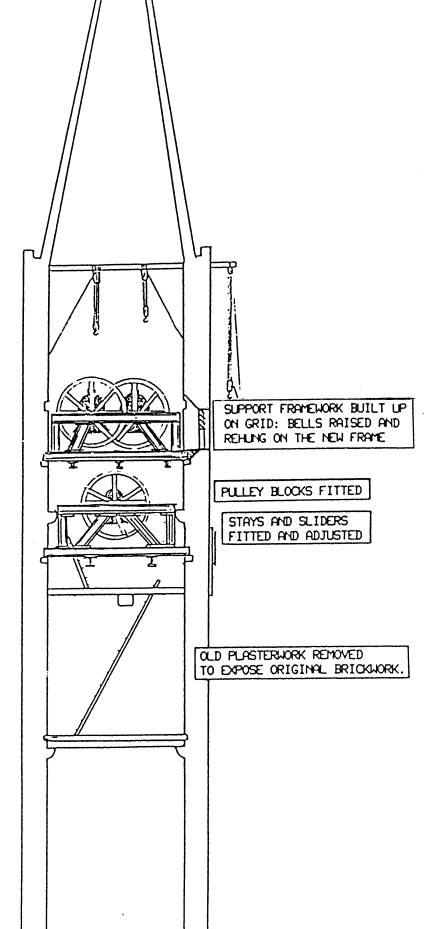
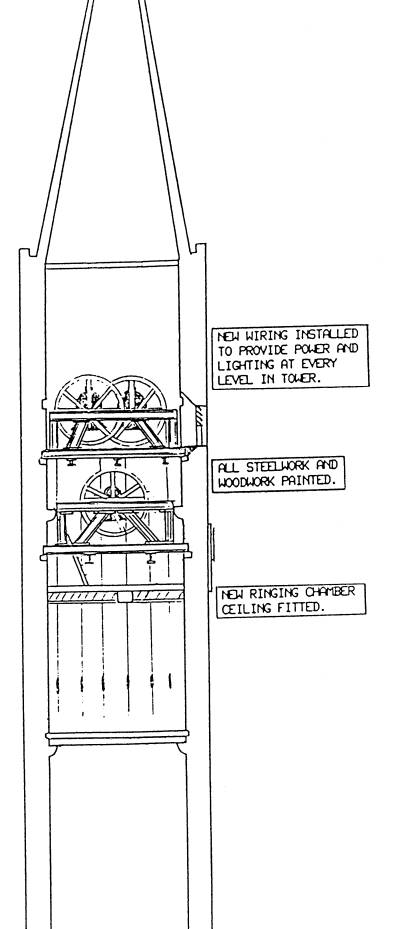
Job done!